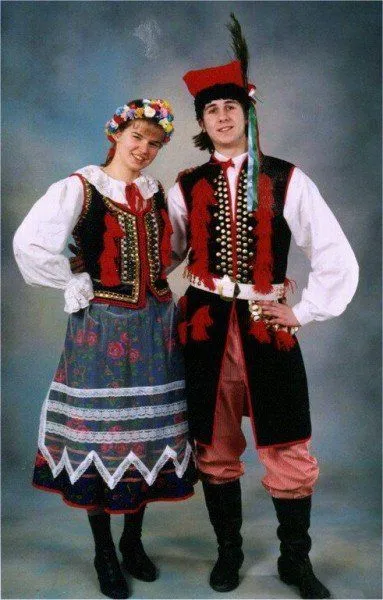Polish history and culture are inextricably intertwined with the country’s traditional folk dress. The vivid colors and intricate needlework ornamentation of the Polish national attire are sure to catch anyone’s eye.
Traditional clothing differs from place to region; there is no universally recognized style. Ethnologists examine 60 examples of women’s traditional Polish attire and uncover 60 distinct styles. A woman’s traditional garb entails a vest, skirt, white shirt, apron, and some form of folk headdress, such as a wreath.
The history, climate, industry, social standing, and marital status of the region in Poland from which a garment originates also affect both design and its appearance.
Polish folkwear has a lovely Slavic aesthetic. And these garments are works of art. Polish folk costumes took their final shape in the second part of the 19th century, at the turn of the 20th, when the country’s poorer classes were more active in the country’s economic and trading roles.
After the widespread introduction of factory-made clothing, traditional Polish dress was reserved for special events such as weddings, festivals, harvest celebrations, religious holidays, and other celebrations.
The costumes are a visual indicator of the wearer’s socioeconomic standing, marital status, and cultural background. The clothing was heavily influenced by the styles worn by the upper classes (gentry, kings, noblewomen, noblemen, and landlords) and the military. However, the most significant impact came from the Baroque & Renaissance eras of dress. These elements combined to produce Poland’s famously vibrant, feminine, and ornate folkwear.
Polish folk clothing, worn by both sexes, is extremely functional and comfortable, as it does not restrict movement and appears to have been made with the wearer in mind rather than merely for display.
Krakovian Folk Dress
Although there are more than 50 distinct Polish traditional costumes, there is one that stands out as the most elaborate and well-known. Krakow is the second-largest city in Poland, and this traditional costume takes its name from it. Let’s learn about this traditional dress for men and women in detail:
Traditional dress for men
The kaftan and zhupan, both outerwear items for men, are the most recognizable styles. They are often red, blue, red, and white in color, and have a variety of embellishments including embroidery and braiding.
A long vest is another option for an outer layer. It may come up to a man’s knees. It’s belted and has a front opening. This item of clothing is typically elaborately embellished and has two huge pockets.
Underneath any outerwear, a plain white shirt (either linen or quality cotton) is worn. Embroidery is common around the collar and cuffs.
Men typically wear striped linen pants that are tucked into knee-high leather boots.
A man’s attire isn’t complete without a belt. A leather belt that is light brown in color, wide, and decorated would be part of typical Krakovian attire.
The hat stands out and is quite peculiar. The name for this square with four sides is “krakuska.” Red and black are the traditional colors for it. There are flowers, feathers, & ribbons on the cap.
Traditional dress of women
The floral-print skirt and the bodycon bodice adorned with embroidery and beads are the most prominent pieces of clothing.
The skirt is just below the knee and has a slight flare; the fabric is printed with tiny flowers and is quite vibrant and vivid. Women typically wear white petticoats under their skirts, with embellishments at the hem. A lace apron, typically sheer and feminine, is worn over the skirt.
Black velvet, cotton, brocade,or other fabrics are used to make the bodice, which is then elaborately decorated with embroidery, sequins, beads, and braiding. There is a placket of buttons or laces up the front to secure it. It resembles a corset, but has no boning.
A white linen or cotton shirt embellished with embroidery or lace is an essential component of any authentic Slavic ensemble. Polish women’s shirts frequently include bell-shaped cuffs made of lace.
A huge kerchief is put over the woman’s shoulders to add another layer of insulation to her outfit. It comes in a variety of primary colors and features a bold and colorful flower pattern.
In addition, one must wear white tights and either red or black shoes or boots.
The hair of young women is typically braided in one or two plaits and decorated with flowers & ribbons. In many cultures, married women are expected to wear some form of head covering, typically a scarf or kerchief over a coif.
Conclusion
Polish clothing is bright, varied, and associated with celebration. The various parts of the country each have their own special characteristics. It’s a shame that Polish people only wear their traditional costumes on holidays and other special occasions.


